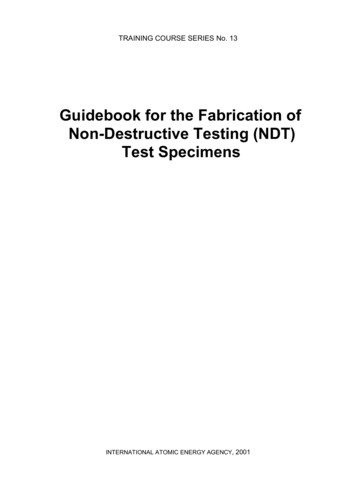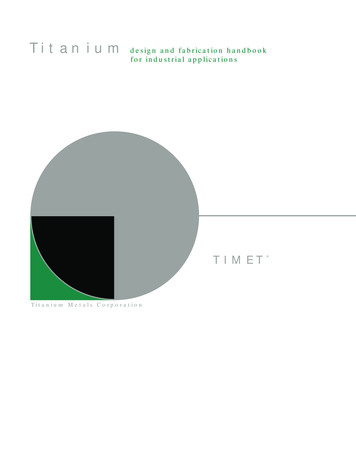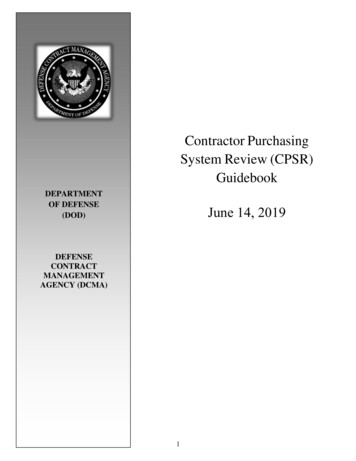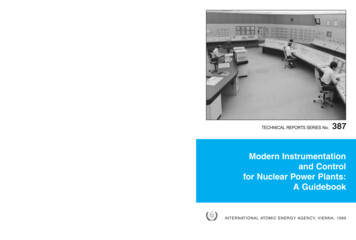
Transcription
TRAINING COURSE SERIES No. 13Guidebook for the Fabrication ofNon-Destructive Testing (NDT)Test SpecimensINTERNATIONAL ATOMIC ENERGY AGENCY, 2001
The originating Section of this publication in the IAEA was:Industrial Applications and Chemistry SectionInternational Atomic Energy AgencyWagramer Strasse 5P.O. Box 100A-1400 Vienna, AustriaGUIDEBOOK FOR THE FABRICATION OFNON-DESTRUCTIVE TESTING (NDT) TEST SPECIMENSIAEA, VIENNA, 2001IAEA-TECDOC-TCS-13ISSN 1011–4289 IAEA, 2001Printed by the IAEA in AustriaJune 2001
FOREWORDThe International Atomic Energy Agency (IAEA) is promoting the industrialapplications of radiation technology, which include non-destructive testing (NDT) under itsvarious programmes such as individual country technical co-operation (TC) projects, regionalprojects and co-ordinated research projects (CRPs). The NDT technology is essentially neededfor the improvement of the quality of industrial products, equipment and plants all over theworld, especially in the developing Member States. An important feature of the NDTprogramme, notably in the East Asia and Pacific (RCA) region, has been the establishment ineach of the Member States of a system for training and certification of NDT personnel basedon the International Organization for Standardization standard ISO/FDIS 9712-1999, “Nondestructive Testing: Qualification and Certification of Personnel”. The main focus is thecreation of a core group of personnel who are trained and qualified to establish the trainingand certification process in their respective countries. An important requirement for such aprocess is to have appropriate training materials that include, among others, NDT testspecimens having standard known dimensions and in-laid artificial defects simulating the realdefects that can or may occur in industrial components.NDT test specimens constitute a very important part of training and certification of NDTpersonnel and are important for carrying out actual inspection and testing, and for achievinginternational harmonization of NDT practices. Naturally, therefore, there is a need to paygreater attention to this subject. A number of seminars and workshops on NDT test specimenshave been organized for this purpose during the past years under various RCA regionalprojects while a number of additional activities, such as regional training courses andseminars, are planned for the future.It has always been felt that there is a strong need to have a proper guidebook addressingvarious issues and problems related to the fabrication of NDT test specimens. Such a bookwould be useful for conducting training courses on this theme in the future, thereby spreadingthe know-how for the fabrication of NDT test specimens and establishing and strengtheningeducation, training and certification process in many Member States on a sustainable basis.In view of the above, the IAEA organized an advisory group of experts to develop aGuidebook for the Fabrication of NDT Test Specimens. The experts consulted the ISO/FDIS9712-1999 requirements for training and certification of personnel and the suitability ofvarious types of NDT test specimens that are needed to meet such requirements.A set of appropriate NDT test specimens, as well as the methodology and procedures fortheir fabrication, were established. These are presented in this guidebook. The expertsrecommended that these procedures be taken only as a guide, and can be expanded andperfected by the national certifying bodies of the Member States. It was felt that there is theneed to compile similar procedures for the remaining types of test specimens but this couldnot be addressed due to limited time.The IAEA wishes to express its appreciation to the governments and organizations whoprovided financial, technical and administrative support, and to the experts who contributed tothe production of this Guidebook.The IAEA officer responsible for this publication was A.A. Khan of the Division ofPhysical and Chemical Sciences.
EDITORIAL NOTEIn preparing this publication for press, staff of the IAEA made up the pages from the originalmanuscript(s). The views expressed do not necessarily reflect those of the IAEA, the governments ofthe nominating Member States or the nominating organizations.Throughout the text names of Member States are retained, as they were when the text wascompiled.The use of particular designations of countries or territories does not imply any judgement bythe publisher, the IAEA, as to the legal status of such countries or territories, of their authorities andinstitutions or of the delimitation of their boundaries.The mention of names of specific companies or products (whether or not indicated asregistered) does not imply any intention to infringe proprietary rights, nor should it be construed asan endorsement or recommendation on the part of the IAEA.
CONTENTS1.NON-DESTRUCTIVE TESTING: BASIC OVERVIEW OFCOMMON METHODS .11.1. Introduction.11.2. Common NDT methods.21.2.1. Visual inspection .21.2.2. Liquid penetrant inspection .31.2.3. Magnetic particle testing.51.2.4. Radiographic inspection .61.2.5. Ultrasonic testing.81.2.6. Eddy current testing.102.TECHNOLOGY OF WELDING .112.1. General considerations.112.2. Weld designs and positions.112.3. Welding processes — Basic overview of common methods .152.3.1. Manual metal arc welding .152.3.2. Gas metal arc welding .162.3.3. Flux cored arc welding .182.3.4. Submerged arc welding .202.3.5. Gas tungsten arc welding.243.WELD DEFECTS AND DISCONTINUITIES.273.1. General considerations.273.2. Definitions.273.3. Quality assurance .283.3.1. Quality assurance system.283.3.2. NDT flaw characteristics .283.3.3. Evidence/trials .284.EXAMINATION TEST SPECIMEN REQUIREMENTS.294.1. Geometric conditions .294.2. Surface condition and appearance.294.3. Dimensional tolerances .294.4. Selection of raw materials prior to the fabrication of test specimens.294.5. Welding requirements .294.5.1. General considerations.294.5.2. Approval of welding technicians .294.5.3. Welding procedures .304.5.4. Weld repairs.304.5.5. Post weld heat treatment.304.6. Inspection requirements .304.6.1. General considerations.304.6.2. Visual inspection .304.6.3. Non-destructive evaluation.30
5.FLAW CHARACTERISTICS.325.1. Introduction.325.2. Tolerances for intended flaws .325.3. Flaw size/location measurements.336.OTHER IMPORTANT urity and confidentiality .34General design considerations and flaw content of test specimens .34Acceptance criteria for unintended flaws in test specimens .346.4.1. Rejectable flaws.346.4.2. Sensitivity settings, sizing techniques and flaw reportingcriteria for ultrasonic test specimens .356.5. Information to be supplied by the end user to the manufacturer.356.6. Inter-changeability of test specimens between different NDT methods .367.MANUFACTURE OF TEST SPECIMENS .377.1.7.2.7.3.7.4.General considerations.37Porosity .37Pipe or wormholes .38Non-metallic inclusions .387.4.1. Surface breaking inclusions.387.4.2. Inclusions for RT .397.4.3. Inclusions for UT.397.5. Tungsten inclusions .397.6. Lack of fusion .397.7. Incomplete root penetration .407.8. Cracks .407.8.1. Transverse cracks.407.8.2. Underbead cracks.417.8.3. Longitudinal cracks .417.8.4. Crater cracks .427.8.5. Hat cracks .437.8.6. Toe and root cracks.437.9. Undercut.437.10. Concavity at the root or surface of the weld .437.10.1. Root concavity.447.10.2. Surface concavity.447.11. Excessive penetration.447.12. Overlap.457.13. Lamellar tearing .457.14. Burn-through .467.15. Root pass oxidation.467.16. Mismatch.467.17. Arc-strike .467.18. Spatter .477.19. Irregular profiles.477.20. Miscellaneous surface imperfections .477.21. Lamination .47
8.NDT METHOD-RELATED TEST SPECIMENS.488.1. Test specimens for liquid penetrant testing.488.1.1. Design and material type(s) of test specimen .488.1.2. Typical flaws .488.2. Test specimens for magnetic particle testing .488.2.1. Typical design of test specimen.488.2.2. Typical flaws .488.3. Test specimens for radiographic testing.488.3.1. Typical design of test specimen.488.3.2. Typical flaws .498.4. Test specimens for ultrasonic testing .498.4.1. Typical design of test specimen.498.4.2. Typical flaws .508.5. Test specimens for visual testing .508.5.1. Typical design of test specimen.508.5.2. Typical flaws .508.6. Test specimens for eddy current testing.509.QUALITY CONTROL OF NDT TEST SPECIMENS .519.1. Handling, shipping, storage and transportation.519.2. Security .51ABBREVIATIONS.53CONTRIBUTORS TO DRAFTING AND REVIEW .55
1. NON-DESTRUCTIVE TESTING: BASIC OVERVIEW OF COMMON METHODS1.1. INTRODUCTIONIt is fact that there are inherent flaws in materials due to crystal lattice imperfections anddislocations however microscopic they may be. Manufacturing processes such as welding,casting, forging, surface treatment, etc. may cause further flaws or defects. Materials are usedunder various conditions of stress, fatigue and corrosion, which may create additional defectsor aggravate present ones. It has been established that most material failures occur becausethese defects reach dangerous proportions such that remaining parts of the materials could notwithstand the stress they are subjected to, thus become ductile or brittle.There is, therefore, a need to detect these flaws and evaluate them in terms of theirnature, size and location. Further steps should be to assess (a) how severe and dangerous theflaws are in their present state, (b) whether they need to be removed by repairing the testedcomponent, (c) if the component be scrapped, or (d) with known flaws, if the product can beallowed to go into service. These are done through inspection and testing.One method of inspection is to subject the material or weld to destructive tests, whichwould provide information about the performance of that test object. The disadvantage ofdestructive testing is that, as the name implies, the test object is destroyed in the process.Therefore, testing methods have been developed to provide the information required of thetest object without rendering it unfit for service.These methods are referred to as non-destructive tests because they permit evaluation ofthe material or component without destroying it. Destructive testing of parts can be expensiveand assumes that the untested parts are of the same quality as those tested. Non-destructivetests give indirect yet valid results and, by definition, leave the test object fit for its intendeduse.There are a variety of NDT methods that can be used to evaluate the materials,components as well as completed welds. All NDT methods share several common elements.These elements are:¾¾¾¾¾some source of probing energy or some type of probing mediumdiscontinuity that must cause a change or alteration of the probing mediumsome means of detecting the changesome means of indicating the changesome means of observing and/or recording this indication so that an interpretation canbe made.The suitability of any NDT method for a given application will be determined byconsidering the above elements. The source of the probing energy or probing medium must besuitable for the test object and for detecting the defect or discontinuity sought. If present, adefect or discontinuity must then be capable of somehow modifying or changing the probingmedium. Once changed, there must be some way of detecting these changes. These changes tothe probing medium by the discontinuity must form some indication or otherwise be recorded.Finally, this indication must be reviewed in order for it to be interpreted and classified.1
Various NDT methods have been developed, each one having advantages andlimitations making it more or less appropriate for a given application. With the variety ofNDT methods available, it is important to select the method that will provide the necessaryresults. A combination of different NDT tests may be applied to provide assurance that thematerial or component is fit for use.1.2. COMMON NDT METHODSWhile there are many different methods of NDT only the more common NDT methodsused for the evaluation of materials and welds will be outlined here. These methods are thefollowing:(1)(2)(3)(4)(5)(6)Visual inspectionLiquid penetrant inspectionMagnetic particle testingRadiographic inspectionUltrasonic testingEddy current testing1.2.1. Visual inspectionVisual inspection (VT) relies upon the detection of surface imperfections using the eye.Normally applied without the use of any additional equipment, VT can be improved by usingaids such as a magnifying glass to improve its effectiveness and scope.VT is considered to be the primary NDT method. Since it relies on an evaluation madeusing the eye, VT is generally considered to be the primary and oldest method of NDT. Withits relative simplicity and because it does not require sophisticated apparatus, it is a veryinexpensive method thus provides an advantage over other NDT methods. A furtheradvantage of VT is that it is an ongoing inspection that can be applied at various stages ofconstruction.The primary limitation of VT is it is only capable of evaluating discontinuities, whichcan be seen on the surface of the material or part. Sometimes there may be some visualindication of a subsurface imperfection that may need an additional NDT method to provideverification of the subsurface discontinuity.VT is most effective when it is performed at all stages of any new fabrication, and is themain method used during the inspection of pressure equipment.If applied say after welding has been completed, it is possible that subsurface flaws maynot be detected. Therefore, it is important to appreciate that VT will only be fully effective if itis applied throughout any fabrication or inspection. An effective VT programme if applied atthe correct time will detect most defects or discontinuities that may later be found by someother costly and time consuming NDT method. The economics of VT can be seen in weldingif we consider how much easier and inexpensive a welding problem can be corrected whenfound at the right time, i.e. as it occurs.2
For example, a flaw, such as incomplete fusion at the weld root, can be repaired easilyand quickly right after it is produced, saving on expense and time required repairing it afterthe weld has been completed and inspected using some other NDT technique.VT will also give the technician instant information on the condition of pressureequipment regarding such things as corrosion, bulging, distortion, correct parts, failures, etc.VT requires three basic conditions to be in place. These are:¾¾¾good vision, to be able to see what you are looking forgood lighting, the correct type of light is importantexperience, to be able to recognize problems.As mentioned previously, one of the advantages of VT is that there is little or noequipment required, which improves its economy or portability. Equipment, which may beemployed to improve the accuracy, repeatability, reliability, and efficiency of VT, includevarious devices. Magnifying glasses may also be utilized for a more detailed look at somevisual feature. However, care must be taken to avoid making erroneous decisions regardingthe size or extent of some discontinuity when its image is magnified.As mentioned before, the primary limitation of VT is that it will only detect surfacediscontinuities. It is also limited to the visual acuity and knowledge of the technician.In order to preserve the test results, various methods can be employed. These include:drawing a sketch, describing the visual appearance using written words, or taking aphotograph or video of the surface conditions noted. It is important to accurately record thelocation, extent, and type of any defect so that the owner, designer, principal and productionpersonnel know what requires repair and where the repair is to be carried out.1.2.1.1. Limitations(a)(b)(c)(d)Restricted to surface inspectionGood eyesight requiredGood lighting requiredPerson performing the inspection must know and be able to recognize what he/she islooking for.1.2.1.2. Advantages(a)(b)(c)(d)Primary method of inspectionOn-going inspectionMost economical inspection methodApplicable at any stage of fabrication.1.2.2. Liquid penetrant inspectionLiquid penetrant inspection (PT) reveals surface flaws by the “bleed-out” of apenetrating medium against a contrasting background. This is done by applying penetrant tothe pre-cleaned surface and flaw of the item being inspected. The penetrant is applied to thesurface and allowed to remain on the surface for a prescribed time (dwell time); the penetrant3
liquid will be drawn into any surface opening by capillary action. Following removal ofexcess penetrant an application of a developer reverses the capillary action and drawspenetrant from the flaw. The resultant indications reveal the presence of the flaw so that it canbe visually inspected and evaluated.Within the categories of penetrant inspection are a family of tests, these relate to thetype of penetrant used. There are also two ways in which penetrant materials are classified,typically the type of indication produced and the method of removal. Penetrant testing resultsare displayed in two ways, visible and fluorescent. The visible penetrant type produces a boldred line or strain indication against a white developer background when viewed under goodwhite light conditions. The fluorescent penetrant produces a green, fluorescent indicationwhen observed under an ultraviolet (black) light. Because the human eye can more readilyperceive a fluorescent indication than a visible indication, the use of fluorescent penetrantinspection will result in a more sensitive test.The second way in which penetrants are classified is the method by which the excesspenetrant is removed from the test surface. The penetrants are either water washable, solventremovable or post-emulsifiable. Water washable penetrants contain an emulsifier that allowsthe penetrant to be rinsed off using low-pressure water spray; sometimes a water-dampenedtowel is used. Solvent removal penetrants require a solvent to remove the excess penetrantfrom the test surface. Post-emulsifiable penetrants are removed by adding an emulsifier afterthe penetrant dwell time. By combining the characteristics of these two classifications, sixdifferent types of penetrants can be used.1.2.2.1. Types of penetrant(1)(2)(3)(4)(5)(6)Visible/water – washableVisible/solvent – removableVisible/post – emulsifiableFluorescent/water – washableFluorescent/solvent – removableFluorescent/post – emulsifiable.With any of these types, application and use is considered the same, except for postemulsifiable penetrant that requires an emulsifier application step. With any of the methods,there are several steps to follow. It is important that each of the steps is performed carefully inits correct sequence; otherwise, the test results may not be reliable.Liquid penetrant testing is used by all industries where there is concern about the surfacecondition of a material or welded joint. It is used extensively on non-magnetic materials, i.e.stainless steel and aluminium that cannot be evaluated using magnetic particle testing.1.2.2.2. Limitations(a)(b)(c)(d)(e)4Access required for surface preparation and cleaningSurface condition must be satisfactoryNon-relevant indications from irregular surfacesWill only detect surface flawsFlaw must be clean and not contaminated.
1.2.2.3. Advantages(a)(b)(c)(d)EconomicalAid to VTPortableCan inspect a wide range of materials and components.1.2.3. Magnetic particle testingMagnetic particle testing (MT) is used to locate surface and slight subsurfacediscontinuities or defects in ferromagnetic materials. Such flaws present in a magnetized partwill cause a magnetic field, i.e. flux, to leave the part. If magnetic particles are applied to thissurface, they will be held in place by the flux leakage to give a visual indication.While several different methods of magnetic particle tests can be used, they all rely onthis same general principle. Therefore, any magnetic particle test will be conducted bycreating a magnetic field in a part and applying the magnetic particles to the test surface.To understand the principle of MT, it is necessary to have some basic knowledge ofmagnetism. Therefore, consider some of the important characteristics of magnetism in andaround typical bar magnet.First, there are magnetic lines of force, or magnetic flux lines, travelling from one end(or pole) of the magnet to the opposite end (pole). These poles are generally designated as thenorth and south. The magnetic flux lines form continuous loops that travel from one pole tothe other. These lines generally remain parallel to one another and will not cross each other.Also, the force of these flux lines (and therefore the flux density of the resulting magneticfield) is greatest when they are fully contained within a ferromagnetic material. Although theywill travel through air gaps, their intensity is reduced as the length of the air gap is increased.I
applications of radiation technology, which include non-destructive testing (NDT) under its . personnel and are important for carrying out actual inspection and testing, and for achieving international harmonization of NDT practices. Naturally, therefore, there is a need to pay . TECHNOLOGY OF











